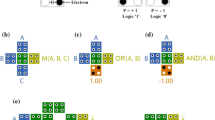Abstract
This paper presents possible designs for high speed error tolerant adder using Gate Diffusion Input (GDI) technique. The 1-bit modified full adder (MFA) proposed in [1] is implemented using GDI technique (GDI-MFA). The GDI-MFA is extended to implement a 16-bit high speed error tolerant adder (GDI-HSETA). The performance of various configurations is studied based on metrics such as delay, area and power dissipation. The circuits have been simulated using pSPICE software. From the results it is observed that the proposed GDI-MFA has 52% less transistor count and consumes 33% less power compared to conventional adders. Results of simulation of GDI-HSETA and other adders in pSpice indicate that the proposed adder has 21.6% power reduction and 13% less transistor count. Also, based on the implementation of GDI-HSETA and existing 16-bit adders on FPGA Spartan 6 platform, it is observed that GDI-HSETA achieved power reduction compared to 16-bit adders using conventional design.





















Similar content being viewed by others
References
Geetha S, Amritvalli P (2017) High speed error tolerant adder for multimedia applications. J Electron Test 33(5):539–688
Shyh-JyeJou C-YC, Yang E-C, Chau-Chin S (1997) A pipelined multiplier-accumulator using a high-speed low-power static and dynamic full adder design. IEEE J Solid-ST Circ 32(1):114–118
Andrew B, Seokhyeong K (2012) Accuracy-configurable adder for approximate arithmetic designs. Proc. Des Aut Con San Francisco, CA, USA. https://doi.org/10.1145/2228360.2228509
Alioto M, Palumbo G (2002) Analysis and comparison of the full adder block. IEEE T VLSI Syst 10(6):806–823
Shoba M, Nakkeeran R (2016) GDI based full adders for energy efficient arithmetic applications. Engineering Science and Technology Int J 19:485–496
Vahid F, Mohammad RT, Keivan N, Arash AM (2014) Design of two low-power full adder cells using GDI structure and hybrid CMOS logic style. Integration. 47(1):48–61. https://doi.org/10.1016/j.vlsi.2013.05.001
Morgenshtein A, Fish A, Wagner IA (2002) Gate-diffusion input (GDI): a power-efficient method for digital combinatorial circuits. IEEE Trans VLSI Syst 10(5):566–581
Morgenshtein A, Yuzhaninov V, Kovshilovsky A, Fish A (2014) Full swing gate diffusion input logic- case-study of low-power CLA adder design. Integr VLSI J 47:62–70
Ning Z, Wang LG, Weija Z, Kiat SY, Zhi HK (2010) Design of low-power high-speed truncation-error-tolerant adder and its application in digital signal processing. IEEE T VLSI Syst 18(8):1225–1229
Sakthivel R, Harish M (2014) Energy efficient low area error tolerant adder with higher accuracy. Circ Syst Signal PR 33(8):2625–2641
Shalem R, John E, John LK (1999) A novel low-power energy recovery full adder cell. In: Proc. GR LAK SYMP VLSI. https://doi.org/10.1109/GLSV.1999.757461
Sumeer Gl AK, Magdy BA (2006) Design of Robust, energy efficient full adders for deep-sub micrometer design using hybrid CMOS logic style. IEEE tRansactions on Very Large Scale Integration Systems 14(12):1309–1321
Shams AM, Bayoumi MA (2000) A novel high-performance CMOS 1-bit full-adder cell. IEEE Transactions On Circuits And Systems—II: Analog And Digital Signal Processing 47(5):478–481
Shams AM, Darwish TK, Bayoumi MA (2002) Performance analysis of low-power 1-bit CMOS full adder cells. IEEE Transactions on Very Large Scale Integration 10(1):20–29
Subodh W, Rajendra KN, Sudarshan T (2012) Performance analysis of high speed hybrid CMOS full adder circuits for low voltage VLSI design. VLSI Design 2012:1–18. https://doi.org/10.1155/2012/173079
Abu-Shama E, Bayoumi M (1995) A new cell for low power adders. In: Proc Midwest Symp Circuit. https://doi.org/10.1109/ISCAS.1996.541898
Moaiyeri MH, FaghihMirzaee R, Navi K, Nikoubin T, Kavehei O (2010) Novel direct designs for 3-input XOR function for low power and high-speed applications. Int J Electron 97(6):647–662
Navi K, Maeen M, Foroutan V, Timarchi S, Kavehei O (2009) A novel low power full-adder cell for low voltage. Integr VLSI J 42(4):457–467
Navi K, Moaiyeri MH, Faghih Mirzaee R, Hashemipour O, Mazloom Nezhad B (2009) Two new low-power full adders based on majority-not gates. Microelectron J 40:126–130
Jiang Y, Al-Sheraidah A, Wang Y, Sha E, Chung J (2004) A novel multiplexer-based low-power full adder. IEEE Transactions on Circuits and Systems II: Express Briefs 51(7):345–348. https://doi.org/10.1109/TCSII.2004.831429
Uma R and Dhavachelvan P (2012) Modified gate diffusion input technique: a new technique for enhancing performance in full adder circuits. Proc. 2nd International Conference on Communication, Computing & Security. https://doi.org/10.1016/j.protcy.2012.10.010, 6, 74, 81
Ponsudha P, Santha KR (2016) A novel GDI-MUX based low power-high speed 1-bit full adder. International Journal of Advanced Engineering Technology 7(2):1066–1071
Varman P, Du K, Mohanram K (2012) High performance reliable variable latency carry select addition. Proc Design Automation and Test :1257–1262
Verma AK, Brisk P, Ienne P (2008) Variable latency speculative addition: a new paradigm for arithmetic circuit design. Proc Design, Automation and Test . https://doi.org/10.1145/1403375.1403679
Bedrij OJ (1962) Carry-select adder. IRE Trans Electron Comput 11(3):340–346
Vaibhav G, Debabrata M, Anand R, Kaushik R (2013) Low-power digital signal processing using approximate adders. IEEE Tran on Computer-Aided Design of Integrated Circuits And Systems 32(1):124–137
Mohanty BK, Patel SK (2014) Area–delay–power efficient carry-select adder. IEEE T Circuits II 61(6):418–422
Ramkumar B, Harish M (2012) Low-power and area-efficient carry select adder. IEEE Transactions on Very Large Scale Integration Systems 20(2):371–375
Chang TY, Hsiao MJ (1998) Carry-select adder using single ripple-carry adder. Electron Letters 34(22):2101–2103
Vaibhav G, Debabrata M, Sang P, Anand R, Kaushik R (2011) IMPACT: IMPrecise adders for low-power approximate computing. In: Proc. Int. Symp. on Low Power Electronics and design. https://doi.org/10.1109/ISLPED.2011.5993675
Pareek M, Singhal M (2016) Low power high speed area efficient error tolerant adder using gate diffusion input method, Proc. 3rd international conference on signal processing and integrated networks (SPIN), https://doi.org/10.1109/SPIN.2016.7566689
Jothin R, Vasanthanayaki C (2016) High performance significance approximation error tolerance adder for image processing applications. J Electronic Testing 32(3):377–383
Author information
Authors and Affiliations
Corresponding author
Additional information
Responsible Editor: S. Sindia
Publisher’s Note
Springer Nature remains neutral with regard to jurisdictional claims in published maps and institutional affiliations.
Rights and permissions
About this article
Cite this article
Geetha, S., Amritvalli, P. Design of High Speed Error Tolerant Adder Using Gate Diffusion Input Technique. J Electron Test 35, 383–400 (2019). https://doi.org/10.1007/s10836-019-05802-2
Received:
Accepted:
Published:
Issue Date:
DOI: https://doi.org/10.1007/s10836-019-05802-2




